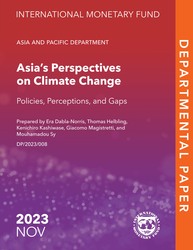
Asia’s Perspectives on Climate Change: Policies, Perceptions, and Gaps
Asia and the Pacific’s green transition will have far-reaching implications for the global economy as the region has become the engine of global economic growth and the largest contributor to growth in global greenhouse gas emissions.
READ MORE...
Volume/Issue:
Volume 2023
Issue 008
Publication date: November 2023
ISBN: 9798400254291
$20.00
Add to Cart by clicking price of the language and format you'd like to purchase
Available Languages and Formats
| English |
Topics covered in this book
This title contains information about the following subjects.
Click on a subject if you would like to see other titles with the same subjects.
International - Economics , Environmental Economics , Environmental Conservation and Protection , Natural Disasters , Public Policy , Public Policy- Environmental Policy , Asia , Climate Change , Mitigation , Adaptation , Nationally Determined Contributions (NDCs) , Industrial Policy , Energy Transition , Renewables , Green Technology , Climate Finance , Critical Minerals , IMF country authority climate survey , IMF country staff report , mitigation policy , Policy instrument , IMF Library , Greenhouse gas emissions , Climate policy , Asia and Pacific , Global , Middle East
Summary
Asia and the Pacific’s green transition will have far-reaching implications for the global economy. Over the past decades, the region has become the engine of global economic growth. With relatively heavy reliance on coal and high energy intensity, the region has recently become the largest contributor to growth in global GHG emissions, accounting for nearly 40 percent of the total emissions in 2020. Achieving net zero by 2050 requires an energy transition at an unprecedented scale and speed, even as the region must ensure energy security and affordability. The region must also address its vulnerability to climate change as it comprises many countries highly exposed to climate hazards increasing in severity and frequency with global warming. If managed well, the green transformation in Asia and the Pacific will create opportunities for economies not only in the region, but also around the world for inclusive and sustainable growth. The global economy is still far from achieving net zero by 2050, and the Asia and the Pacific region must play its part to deliver on mitigation and adaptation goals. Understanding Asia’s perspectives on the constraints and issues with climate ambitions, climate policy actions, and constraints is central for devising climate strategies to meet climate goals. To this end, this chapter draws on novel surveys of country authorities and public in the region to distill climate ambitions and challenges faced and identify sources of major gaps in achieving mitigation and adaptation goals. Measures to help close the gaps are drawn from policy discussions with country authorities in bilateral surveillance and related studies.
Copyright © 2010 - 2026
Powered by:
AIDC



